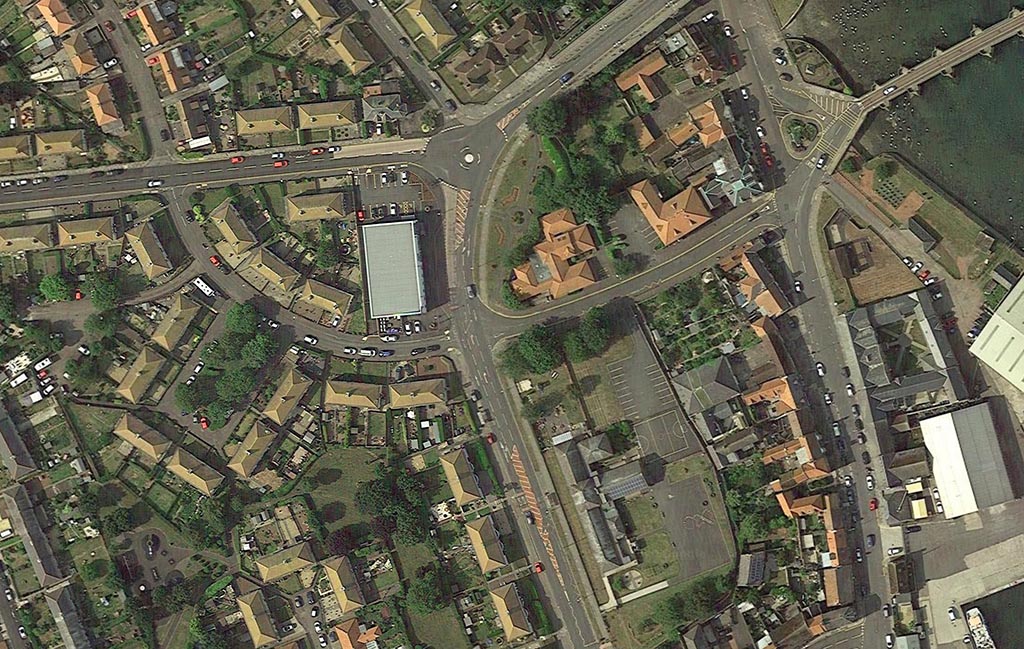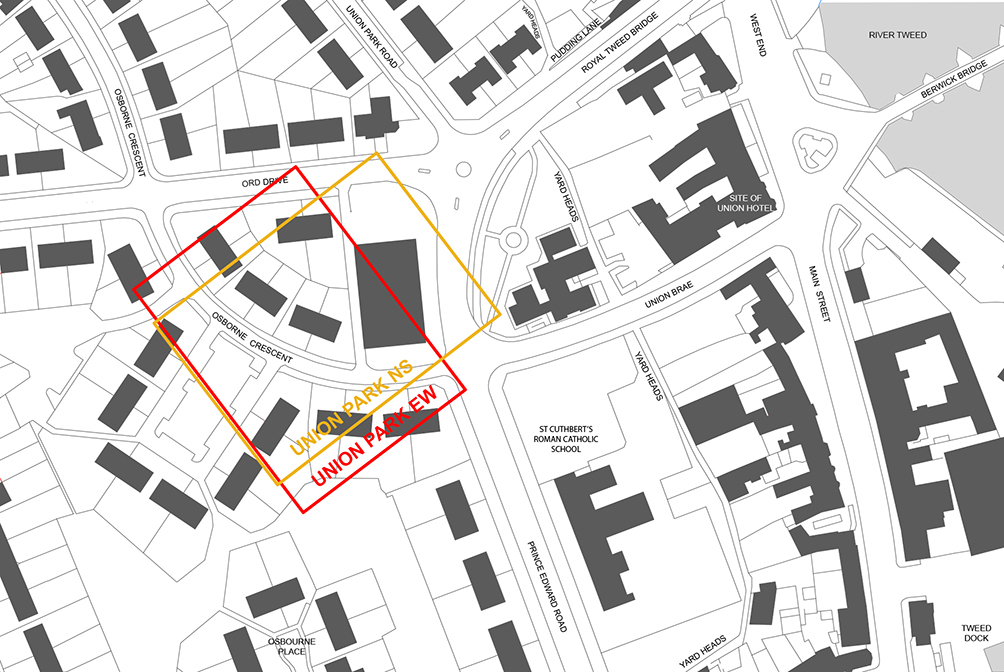
Union Park


Google aerial view of the Union Park and surrounding area.
Hover image to enlarge


Overlay map view showing the location of the Union Park before and after the pitch realignment.
Hover image to enlarge


A view of the Union Park in June 2020. The whole pitch area is now covered by residential and commercial properties with only the small grassed area in the foreground still bearing the Union Park name.
Hover image to enlarge
At the start of the 1900/01 season, there were doubts as to whether Berwick Rangers would continue. It was felt that having won the North Northumberland League the previous season without losing a single match, there was little point in playing on without more suitable competition. As a result, Rangers did not renew their interest in Shielfield.
The Rangers’ committee thought that Shielfield was outwith their territory and that the Berwick public would not travel so far. The Club applied to the Cricket Club in hope of securing again their old portion of the Pier Field, but the application was turned down due to possible damage to the field. Rangers were offered the use of the pitch used by the Grammar School, but it was well known that they would not attract the crowds expected being so far out of town.
Mr. Robert Russell of the Union Hotel, Bridge End, Tweedmouth, came to the Rangers’ rescue when he offered the use of his field behind, and negotiations to lease the field were quickly made. The new ground was to be appropriately named Union Park. The field was only a five-minute walk from the High Street and of a size that, with a little bit of groundwork, would enable the club to take their proper place in football circles, not only in the borough, but beyond, and the club was in a hurry to get the pitch ready in time for their opening match against Duns on 29th September.
However, visitors to the match were surprised to find Union Park drawn blank. Mr. Russell had gone back on his word, and an alternative venue had to be quickly found. Robert Marshall of Tweedmouth Town Farm came to the club’s rescue when he allowed the match to take place on his enclosure, the Meadow Field, further up the road and recently vacated by Tweedside Albion, who were the new tenants of Shielfield.
New negotiations to lease the Union Park for the 1901/02 season were quickly made. Robert Marshall of Tweedmouth Town Farm had become the new owner of the field and, due to his close ties with the Rangers, an agreement was amicably made. A friendly encounter with Cumledge Mill, on 28th September 1901, was the first match to be played on the Union Park, but it was no cause for celebration as the visitors won 3-1.
Berwick Rangers started the 1902/03 season with the usual problem – no field on which to play. They were unable to secure the use of Union Park and the opening games of the season were to be played away from home. Negotiations for the use of the Union Park were concluded in time for Rangers’ Minor Cup first round tie against Amble Blue Star on 22nd November.
A rise in rental, combined with financial constraints for the 1906/07 season, made it impossible for the Rangers to continue playing at the Union Park and committee approached Mr. William Shiel Dods, who kindly agreed to place the now vacant ground at Shielfield at the disposal of the club at a very nominal rent, although the opening fixtures of the season were to take place on the Union Park.
After a disappointing season, combined with poor attendances at Shielfield, calls were made by supporters for a return to Union Park, which was considered the best central field in the borough, for the 1908/09 campaign. The loss of the Union Park was not only a disaster for Berwick Rangers, but also a blow to local football supporters in general. Negotiations took place on a five-year lease but, due to the limited timescale, it was agreed to take Shielfield for the same rent as before with the first few matches, at least, to be played there.
A visit by Peebles Rovers, in the first round of the ESFA Qualifying Cup on 29th August, was the first match to be played on the Club’s return.
In order to comply with new regulations stipulated by the Scottish Football Association, the club was obliged to provide, amongst others, separate changing facilities for both teams and the referee. With the regulation in mind, the committee showed great enterprise by purchasing, as a pavilion, the Old Cookery School, which once stood in the playground of the Girls’ National School on Northumberland Avenue, from Mr. B. G. Sinclair for the sum of £35. It had been removed from the school after having being erected contrary to local bye-laws and later it became a store in a builder’s yard belonging to Mr. Sinclair on Ness Street. Further ground improvements were carried out during the month of December with the playing area being flattened and considerably extended, along with a barrier built around the pitch. The pavilion was of a wooden construction with a tin roof, the slope of which gave ideal conditions for a covered stand, which was added to give some spectators a better view and more comfort for their “tuppence” extra.
An exhibition friendly with the Rangers of Glasgow was held on Thursday April 14th for the grand opening of the new pavilion. Rangers fielded a very strong side and routed Berwick 6-1. The gate, which was in excess of 2000 spectators, raised over £22.
Football in the borough was slow to emerge from the shadows of the First World War. Spittal Hearts and the reformed Tweedside Albion began playing friendlies in the early months of 1919, but the future of Berwick Rangers still hung in the balance.
There was nothing was left of the old club. The lease on the Union Park had lapsed; the Pavilion, along with the fencing, had been sold for building materials for the sum of £18 and even the players’ shirts had been disposed of.
On the question of a playing field it was thought that there would not be much of a problem in securing the use of the Union Park from new owner Mr. John Robertson of the Mill Farm, Tweedmouth, at least until the start of the newly proposed housing scheme. However, Spittal Hearts, after a failed attempt to amalgamate with Tweedside Albion, had changed their name to Berwick United and were also in negotiations for the ground.
Both Rangers and United had ambitions of join the ESFA and SFA and playing in their associated competitions. No club was to be admitted to either association unless they had a private ground of their own and on this front Berwick United were at the fore – they had acquired the lease of the Union Park from under the noses of the Rangers. In response, Rangers moved quickly to secure the use of the old football field at Shielfield for the season. Their only real concern was the out-of-the-way location of the Shielfield ground and the consequent difficulty in getting even the most enthusiastic supporters to the top of Tweedmouth.
It was felt by many that a large part of the Rangers’ problem was that the town could only support one club and that they should amalgamate with Berwick United. If there was only one well managed team in the borough it should be as successful as the Rangers in seasons past when honours were won. The recently formed Scremerston Football Club was about to join the North Northumberland League for the 1920/21 season and may draw some of the better players away. However, no approach was made by United on the matter and it later transpired that they were not going to reform for the new season, leaving Rangers to go it alone in the borough.
Due to the demise of Berwick United, the Union Park was vacant and the committee moved quickly to secure the use of their old playing field. The owner, Mr. John Robertson, accepted £30 rent for the field and £3 for the use of the nearby stables for stripping quarters, from August 1st to April 30th, on condition that the club made good all damages done.
The Club could only secure 12-month agreements on the Union Park due to the possibility of the recent house building scheme being expanded and the building of the new bridge and approach roads. There was no suitable field available in Berwick and only one left in the middle of Tweedmouth, adjacent to the present ground and belonging to Lord Osborne, would be impossible to buy it at the present time.
During pre-season 1923/24, due to the encroachment of the new housing scheme onto the field, the pitch was turned on its axis to face more north to south than east to west; the playing area being reduced to the minimum requirements to fit the flat of the land between the recently built bungalows on Osborne Place and Yard’s Head. Rangers had been offered the old football ground at Shielfield for £500, but as it was only agricultural land it was thought that £40 per acre was more like it and the committee decided to start the season at the Union Park.
By the start of the 1924/25 season, negotiations to use the old playing field behind Shielfield Terrace were still proving unsuccessful and Rangers were given use of the Union Park for the start of the season at least. Work on the new bridge and approach roads was making ground by the day and the club would sooner or later have to make their exit.
By autumn 1925, the approach roads to the new bridge over the River Tweed were soon to severe the playing surface at the Union Park, making the finding of a new ground imperative. Whilst this was a good thing from the playing side of view, due to size restrictions, it was centrally located and it was thought that a better situated venue would be hard to find. The town council were approached for the use of part of the Magdalene Fields for a ground, but they quickly pointed out that it was not up to them to provide the Club with a field on which to play.
The only ground available that was in anyway suitable was Shielfield, which was on the market, but only on condition that the purchase was made immediately. A public meeting was held with the result that the Shielfield Park Company was formed with many of the townsfolk subscribing. Trustees were appointed to purchase the field and in turn let it to the football club at a rental of £35 per annum. Work started immediately to bring the ground up to a suitable standard with many of the club’s committee members giving their time gratis.
The last ever match played on the Union Park was against Vale of Leithen in the second round of the King Cup, on 31st October 1925, when Berwick Rangers outclassed the visitors to win 5-2.